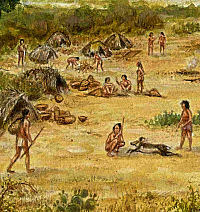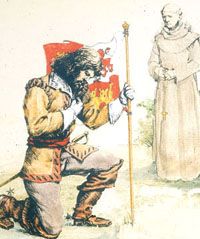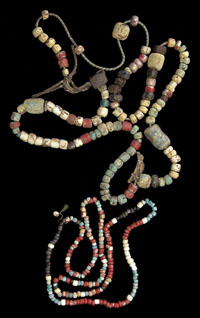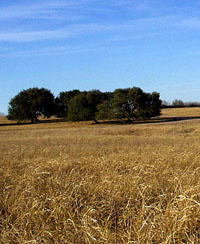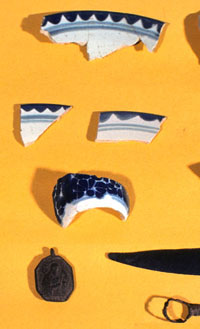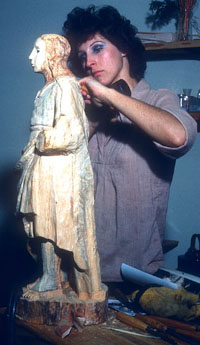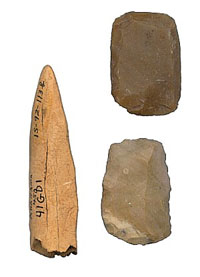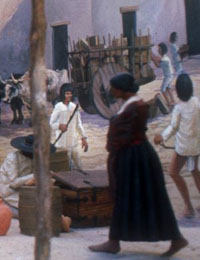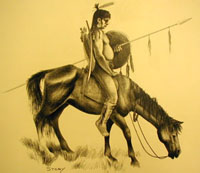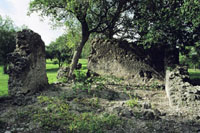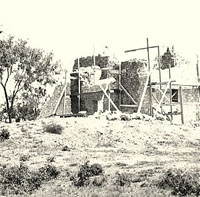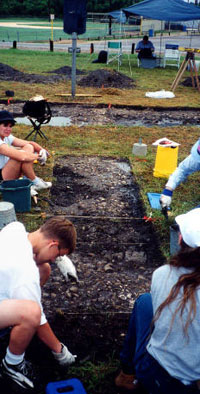Tracing a Mission and Its People
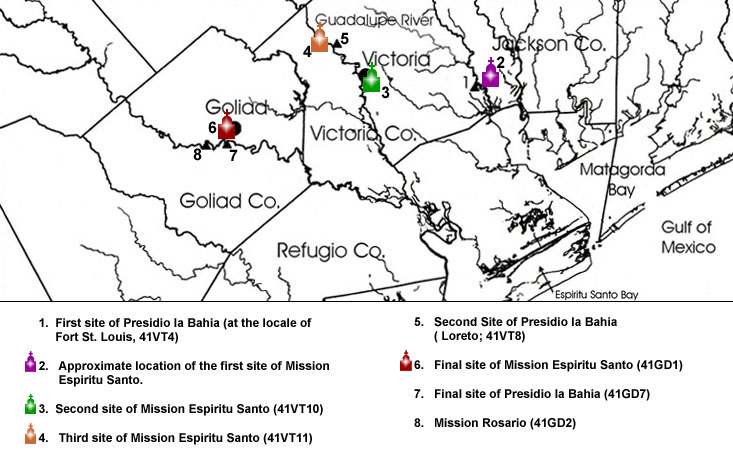 |
|
A Mission on the Move Plans were made to move both the mission and presidio roughly 10 leagues (30 miles) inland to the Guadalupe River valley. Here, the friars would work among the Aranama and Tamique Indians, who appeared more open to Christian teachings. In this area, two missions bearing the name Espíritu Santo ultimately were built, perhaps operating at the same time to serve the large numbers of Aranamas. The first mission, established in 1725, apparently was constructed in some haste in advance of the relocation of the presidio from the coast and even before the friars received official permission to relocate from the original site. A year later another mission as well as the presidio was built closeby, in an area along the Guadalupe River known today as Mission Valley. Once again the friars contended with a difficult environment as they struggled to establish a self-sufficient operation. Although their efforts to dam the Guadalupe and irrigate their crops were not successful, the mission group accomplished a system of dry farming that allowed for the vagaries of weather. Several small herds of cattle and other livestock were maintained. In 1749, however, political dictates led to yet another relocation. Mission Espíritu Santo was moved to what was to be its fourth, final, and most successful site, on the lower San Antonio River, near present day Goliad. Here, the mission cattle ranching operation reached its peak. Herds, by some accounts, reached 40,000 head. In the years to come, Mission Espíritu Santo, along with the Royal Presidio of La Bahia, and the town of La Bahia, was to become one of the most important settlements in Spanish Texas. Changes in Spanish laws, however, coupled with raids by hostile tribes, such as the Lipan Apache, brought ruin to the mission herds. By 1780, the cattle holdings of the msision had been reduced to barely one-fifth their former size. The spector of the mounted Apache, well-supplied with food without having to work, damaged the morale of the natives laboring in the mission. Increasingly the neophytes disappeared from the complex to join up with other groups. Disease continued to diminish their ranks as well. By 1786, only 116 people remained in the mission With mounting expenses and increasingly poor results, the colonial offces decided the cost of maintaining the missions was too great. A decree for secularization of the Texas missions was set forth on April 10, 1794. Although the mission was granted an extension of time to try to prepare its native flock for citizenship, there was little provided in the way of funding or administrative support, and the friars’ final attempt was unsuccessful. By 1830, there were no longer any Indians at Mission Espíritu Santo. Although the mission had lasted 109 years—longer than most other missions—the charge to Christianize the native peoples had not succeeded. From a larger perspective, the entire Spanish Colonial system had failed. Investigations and RestorationIn the succeeding decades, the mission structures saw use as Aranama College, a school for men that lasted until the outbreak of the Civil War. Later, the site was used as Hillyer Female Institute. Ultimately, the school lands and buildings were taken over by the city and county of Goliad. Following a violent storm in 1886, the site fell into ruin. Walls crumbled, the stones gathered by area residents for use in other buildings. The mission at its second location also fell to ruin and was eventually leveled, becoming part of a city park in Victoria. For many years its status— whether a visita (interim location) or full-fledged mission—was a confused chapter in history. The site has recently been validated, however, through historical research and archeological investigations. Members of the Texas Archeological Society spent two weeks in 1997 and 1998 excavating that site, locally known as the Tonkawa Banks site. A few standing walls remain of the Mission Espíritu Santo in its third location, now on a private ranch. Situated on the banks of the Guadalupe, the ruin lies only a few hundred yards from an imposing modern house. The landowners, aware of the historical significance of the crumbling structure, welcomed archeologists to the site and hosted excavations by the University of Texas at Austin and by the Texas Archeological Society. The mission complex at the final, Goliad location was investigated archeologically during its 1930s restoration, resulting in the collection of numerous artifacts. Importantly, the site has undergone more testing in the past few decades by archeologists utilizing more modern techniques which have provided more substantive data about the mission residents. Today, the church and other buildings have been fully reconstructed and furnished to provide a glimpse of the site's colorful past. Interpretive exhibits detail not only life at the mission but aspects of the archeological investigations and restoration process that have helped bring the story to life. Learning from the Missions Spanish Colonial records are a rich trove of information and can provide important insights about what occurred at missions, presidios, and other sites in Texas in the past (It was by combing Spanish archives that the second location of Mission Espíritu Santo was validated.). Unfortunately, the records are often spotty and provide only the Spanish perspective. Archeology can address questions that are rarely answered in the historical records. For example, what changes in mission Indian material culture can be observed through time and what does this say about the acculturation process? Is there material evidence to suggest that certain aspects of native life were preserved or re-negotiated after long-term interaction with Europeans? And what evidence, if any, do we have for the impact sustained contact with native populations had on the lives of the padres and the handful of presidio soldiers that called this mission their home? By and large these are not questions that can be answered through a study of the historical documents. Herein lies the strength of historical archeology. Blended with historic research, much more can be revealed about the past. A second major thrust in mission archeology is aimed at understanding the layout and architecture of the sites. What has been found in several cases at historic sites is that the historical record, including maps and drawings, do not agree with the evidence in the dirt. Nor do they always address the earliest, often temporary, structures at sites. Archeological investigations often can serve to "peel back the layers," exposing a more complete and accurate history than what is found in records. At the second and third locations of the mission near Victoria, there were no maps or other sources of data about the structures or their arrangement. Excavations revealed sufficient information to reconstruct the mission layout at both sites. Following the Trail In the following sections we will track the complicated history of Mission Espíritu Santo and examine what has been learned through combining historical and archeological investigations at the three inland locations of the mission. (The mission at its original location, on Garcitas Creek near Matagorda Bay, will be featured in a separate, upcoming regional exhibit, “Early Peoples of the Coastal Plains and Marshes.”) We will also take a look at what life may have been like for both the native and Spanish residents of a mission. |
|
